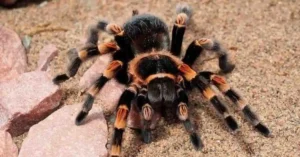Wolf spiders are fascinating and diverse arachnids found worldwide. Their unique traits, behavior, and interactions with humans make them a topic worth exploring. This article delves into their identification, habitat, behavior, ecological significance, and practical ways to manage their presence.
Identification of Wolf Spiders
Wolf spiders belong to the Lycosidae family and are renowned for their agility and hunting skills. Key features include:
- Coloration: Typically brown, gray, or black with darker stripes or markings.
- Body Structure: Sturdy build with long legs aiding in swift movement.
- Eyes: Eight eyes, with two large ones on top for excellent night vision.
- Size: Adult wolf spiders range between 1 to 2 inches long, excluding their legs.
Wolf spiders are often mistaken for similar-looking spiders like tarantulas due to their size and appearance. However, wolf spiders are generally smaller and lack the dense hair covering that tarantulas possess. Additionally, their distinct eye arrangement makes them easily identifiable when closely observed.
Habitat and Distribution

Wolf spiders adapt to a variety of environments, including:
- Forests: Found under leaves or tree bark.
- Grasslands: Hide among plants and grass.
- Deserts: Often burrow in sandy soils for shelter.
- Homes: Occasionally enter basements, garages, or other damp areas.
Their ability to thrive in diverse habitats makes them one of the most widespread spider families. From tropical rainforests to arid deserts, wolf spiders have adapted to survive in both extreme and moderate climates.
Behavior and Hunting Style
Unlike web-spinning spiders, wolf spiders are active hunters. Their behavior includes:
- Hunting Method: Chase and capture prey using speed and acute eyesight.
- Diet: Feeds on insects like crickets, moths, and grasshoppers.
- Reproduction: Females carry egg sacs attached to their abdomen, and spiderlings ride on the mother’s back after hatching.
Wolf spiders are primarily nocturnal and rely heavily on their sharp vision to locate prey in low light. Their keen sense of touch also helps them detect vibrations in the ground, which signals the movement of nearby prey or potential threats.
Are Wolf Spiders Dangerous to Humans?
Wolf spiders are generally not harmful to humans. While they may bite when threatened, their venom is not medically significant. A bite might cause mild swelling or pain, which usually subsides without complications.
If bitten, symptoms can vary depending on individual sensitivity. However, cases requiring medical attention are rare. The wolf spider’s reputation as a dangerous predator is largely a misconception stemming from its imposing appearance.
Ecological Importance of Wolf Spiders
Wolf spiders play a crucial role in ecosystems:
- Pest Control: They help control insect populations, benefiting crops and plants.
- Food Chain Balance: As both predator and prey, they maintain balance in the food web.
Their contribution to pest control makes them beneficial for farmers and gardeners alike. By preying on harmful insects, wolf spiders act as natural pest regulators, reducing the need for chemical pesticides.
Preventing Wolf Spiders in Your Home

To minimize the chances of wolf spiders entering your home:
- Maintain Cleanliness: Keep your home free of clutter and dispose of waste properly.
- Seal Cracks: Repair gaps in doors, windows, and walls.
- Control Lighting: Reduce outdoor lighting at night to avoid attracting insects, which serve as prey for spiders.
You can also use natural repellents like peppermint oil or vinegar to deter spiders. Additionally, regularly inspecting dark and damp areas of your home can help detect and address spider activity early.
Interesting Facts About Wolf Spiders
- Speedy Hunters: Known for their rapid movements and chasing prey.
- Maternal Care: Female wolf spiders carry their young on their back, a rare trait in spiders.
- Night Vision: Their large eyes allow them to hunt efficiently in low-light conditions.
Wolf spiders’ ability to adapt and thrive in different environments showcases their resilience and evolutionary success. Their nocturnal hunting habits and remarkable speed make them formidable predators in their respective habitats.
Types of Wolf Spiders
Several species of wolf spiders are found worldwide, including:
- Hogna carolinensis: The largest wolf spider in North America.
- Hogna aspersa: Common in eastern parts of the United States.
- Sosippus: Known for building funnel-like webs, unlike typical wolf spiders.
Wolf spiders vary greatly in size and appearance depending on their species and location. Despite these differences, all wolf spiders share the same predatory nature and ecological role.
Comparison with Other Spiders
Wolf spiders differ from other spiders in several ways:
- Webs: Do not spin webs to catch prey but actively hunt instead.
- Maternal Behavior: Females take care of their offspring, a trait uncommon among other spiders.
- Hunting Strategy: Relies on speed and vision rather than trapping prey in webs.
This active hunting behavior sets them apart from web-builders like orb-weaver spiders, which rely on stationary webs to capture prey.
Symptoms and Treatment of Wolf Spider Bites
While wolf spider bites are rare, they can occur. Common symptoms include:
- Pain: Mild discomfort at the bite site.
- Swelling: Slight redness or swelling.
Treatment:
- Wash the bite with soap and water.
- Apply a cold compress to reduce swelling.
- Seek medical advice if symptoms persist.
Conclusion
Wolf spiders are remarkable creatures that contribute significantly to their ecosystems. Their active hunting style, maternal instincts, and adaptability make them unique among arachnids. While they are often misunderstood as dangerous, they are generally harmless and beneficial in controlling pest populations.
Understanding wolf spiders can help us appreciate their role in nature and coexist peacefully with these intriguing creatures.
FAQs
1. Are wolf spiders poisonous?
Wolf spiders are not poisonous to humans. Their venom is mild and only harmful to their prey.
2. How can I identify a wolf spider?
You can identify wolf spiders by their sturdy body, brown or gray color with stripes, and eight eyes arranged uniquely, including two large central eyes.
3. Do wolf spiders spin webs?
No, wolf spiders do not spin webs for hunting. Instead, they rely on their speed and agility to capture prey.
4. How can I prevent wolf spiders from entering my home?
Seal gaps in doors and windows, maintain cleanliness, and reduce outdoor lighting to avoid attracting insects that wolf spiders feed on.

James William is a passionate animal lover and expert in the Animals and Pets niche. With years of experience in pet care, wildlife studies, and blogging, James shares practical tips, heartwarming stories, and expert advice to help pet owners build stronger bonds with their furry, feathered, and scaly companions.








